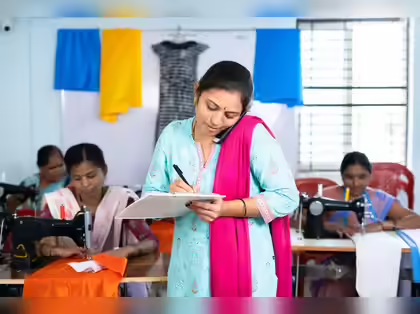- Courses
- GS Full Course 1 Year
- GS Full Course 2 Year
- GS Full Course 3 Year
- GS Full Course Till Selection
- Answer Alpha: Mains 2025 Mentorship
- MEP (Mains Enrichment Programme) Data, Facts
- Essay Target – 150+ Marks
- Online Program
- GS Recorded Course
- Polity
- Geography
- Economy
- Ancient, Medieval and Art & Culture AMAC
- Modern India, Post Independence & World History
- Environment
- Governance
- Science & Technology
- International Relations and Internal Security
- Disaster Management
- Ethics
- NCERT Current Affairs
- Indian Society and Social Issue
- NCERT- Science and Technology
- NCERT - Geography
- NCERT - Ancient History
- NCERT- World History
- NCERT Modern History
- NCERT Medieval History
- CSAT
- 5 LAYERED ARJUNA Mentorship
- Public Administration Optional
- ABOUT US
- OUR TOPPERS
- TEST SERIES
- FREE STUDY MATERIAL
- VIDEOS
- CONTACT US
Women-led MSMEs in India: Issues and Opportunities
Women-led MSMEs in India: Issues and Opportunities

Why in the News?
- Micro, Small and Medium Enterprises (MSMEs) are very important for India’s economy.
- In 2024, they contributed about 30% to India’s GDP. The government wants to increase this to 35%.
- Many women are also running MSMEs, but they still face many problems. One major issue is that they are not able to get enough loans from banks.
What are the Key Highlights?
- Women own about 20% of registered MSMEs, but they contribute only 10% of the total turnover.
- They receive just 11–15% of total investments in the MSME sector.
- The credit gap for women is around 35%, while it is only 20% for men.
|
What is the Credit Gap?
What does a 35% credit gap mean for women?
For men, a 20% credit gap means:
|
- Under the Pradhan Mantri MUDRA Yojana (PMMY), women hold 64% of loan accounts, but get only 41% of total funds.
- Udyam Assist Portal helps informal businesses get recognition. Over 1.86 crore businesses registered in 2024, and 70.5% were women-led.
- These women-led businesses created over 70.8% of new jobs in the informal MSME segment.
- RBI cut the repo rate to 5.50% and reduced the Cash Reserve Ratio by 100 basis points, which makes loans cheaper and more available.
|
Pradhan Mantri MUDRA Yojana (PMMY) |
|
|
Particulars |
Details |
|
Launched By |
Ministry of Finance |
|
Launch Year |
2015 |
|
Purpose |
To provide collateral-free loans to small and micro-enterprises |
|
Target Group |
Small business owners, non-farm workers, women entrepreneurs, artisans |
|
Loan Type |
Term loans, working capital loans, overdraft facilities |
|
Loan Amount Range |
Up to ₹10 lakh |
|
Loan Categories |
Shishu (up to ₹50,000) - Kishore (₹50,001 to ₹5 lakh) - Tarun (₹5,00,001 to ₹10 lakh) |
|
Collateral Required |
No collateral required |
|
Interest Rate |
Depends on the bank and applicant profile (generally 8%–12%) |
|
Repayment Period |
Flexible, as decided by banks (usually 3–5 years) |
|
Implementing Agencies |
Public sector banks, private banks, cooperative banks, MFIs, NBFCs |
|
Key Benefits |
Easy access to credit - Encourages self-employment - Boosts small businesses |
|
Special Focus |
Women, SC/STs, and people from backward areas |
|
As of 2024 (Key Stats) |
64% of PMMY accounts held by women - Women received only 41% of total loan amount |
What are the Significances?
- Women’s involvement in MSMEs is growing, especially in informal businesses.
- Schemes like PMMY and Udyam Assist Portal are helping more women enter the formal economy.
- More loan availability and lower interest rates can support women-led businesses.
- If these businesses grow, they can create more jobs and add more to the economy.
What are the Challenges and Way Forward?
|
Challenges |
Way Forward |
|
1. Many women cannot get the full amount of loan they need. |
Create special credit schemes for women with low or no collateral. |
|
2. Women receive less funding even if they have more loan accounts. |
Ensure fair distribution of loan amounts based on the number of accounts. |
|
3. Poor awareness of government schemes among women in rural areas. |
Start financial education programs and local help centers for women. |
|
4. Banks do not support or guide women properly. |
Train bank staff to support and assist women entrepreneurs. |
|
5. Women are seen as risky borrowers due to lack of property. |
Accept group guarantees or alternate forms of security for women. |
|
6. Women take longer and more visits to get loans than men. |
Set up women-only help desks in banks to reduce bias and speed up processes. |
|
7. Most women work in the informal sector and avoid banks. |
Use platforms like Udyam Assist Portal to bring informal businesses into formal setup. |
Conclusion
India has taken many steps to support women-led MSMEs, but the journey is not complete. These businesses can bring major changes in the economy if they get equal access to loans, proper guidance, and fair treatment. With better planning and support, women entrepreneurs can lead India’s MSME sector towards a stronger and more equal future.
|
Ensure IAS Mains Question: Q. Despite a large number of loan accounts under the Pradhan Mantri MUDRA Yojana (PMMY) being held by women, there remains a significant gap in the credit amount disbursed to them. Critically examine the reasons for this disparity. Suggest measures to ensure equitable financial access for women-led MSMEs. (250 words) |
Ensure IAS Prelim MCQ:Q. Consider the following statements about Pradhan Mantri MUDRA Yojana PMMY:
Which of the statements given above is/are correct? A) 1 and 2 only Answer: B) 3 only Statement 1 is incorrect: PMMY provides loans without collateral. Statement 2 is incorrect: NBFCs, MFIs, and cooperative banks also implement it. Statement 3 is correct: PMMY aims to promote self-employment among small entrepreneurs.
|



